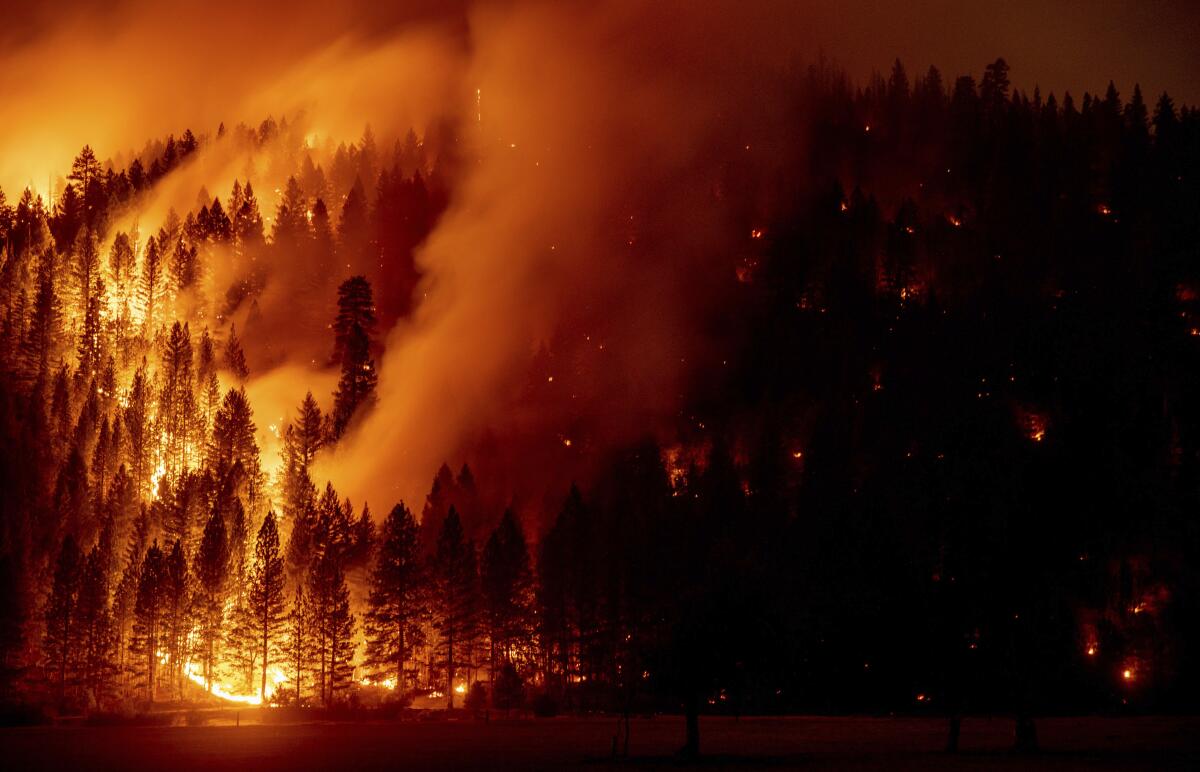Democrats eye massive shift in war on wildfires: Prevention

- Share via
WASHINGTON — Democrats are proposing a potentially seismic shift in how the nation battles wildfires by dramatically increasing funding for efforts that aim to prevent blazes, rather than focusing on the tools to put them out.
Under the social safety-net and climate bill passed by the House and now being negotiated in the Senate, Democrats would funnel $27 billion into the nation’s forests, including a sizable $14 billion over a decade for clearing vegetation and other dry debris that can fuel a fire.
Known as “hazardous fuels reduction,” such proactive measures have been “underfunded for so long,” said Ann M. Bartuska, a senior advisor at environmental nonprofit Resources for the Future and former Forest Service official. “This really cries out and says, ‘All right, we get it, we need to reduce wildfire risk.’”
The growing effects of climate change as well as the intensity of wildfires in the past two years — more than 7 million acres of California went up in flames, sending its smoke across the United States to Congress’ doorsteps in Washington — have forced lawmakers to reconsider how they spend wildfire dollars.
But the funding is not yet secured. Sen. Joe Manchin III (D-W.Va.), a key moderate who has not committed to the bill, has long expressed concern about the overall cost and scope of the $1.85-trillion plan. He has specifically indicated he doesn’t want to see overlap between the recently approved bipartisan infrastructure plan and the social spending bill. That could put a bull’s-eye on the wildfire prevention efforts, which got $3.3 billion in the bipartisan plan.
Still, proponents of the wildfire plan are holding out hope the forestry provisions will survive. A group of Democratic senators from the West took their concerns directly to Manchin earlier this year.
“Six of us from fire-prone states had a chance to sit and describe all the challenges we’re facing,” Sen. Jeff Merkley (D-Ore.) said.
Negotiations over the bill are expected to continue before a vote in the Senate planned for late December. As the entire package was scaled down from the original $3.5-trillion price tag, the scope of the forestry provision has also been halved from $60 billion.
Still, the $27 billion would represent the largest investment the federal government has made in its forests, according to Sen. Michael Bennet (D-Colo.), who introduced a similar forestry bill this year. Funding for the preventative hazardous fuels reduction — to be spread over a decade — is more than double what Congress spent on such efforts annually between 2011 and 2020, according to the nonpartisan Congressional Research Service.
Traditionally, the federal government has focused its wildfire spending on suppression at the expense of prevention. The Interior Department and Forest Service are even allowed to unilaterally move money from any of its programs, including fire prevention, to fund more urgent suppression efforts.
“When you combine the effects of climate change with the profound negligence of the federal government in terms of managing its national forests, these places are profound dangers to our communities and to our economy,” Bennet said.
Local fire officials in California and elsewhere in the West have viewed the federal government as a poor partner in combating wildfires, largely because it has left the Forest Service underfunded.
“It’s very frustrating considering they own over half of the forest land in the state and they’re just not putting up the effort to provide the resources needed,” said Ken Pimlott, a retired chief of the California Department of Forestry and Fire Protection. “The investments, the money they’re getting and the commitments from the federal government have been woefully inadequate.”
While prevention requires more upfront spending, advocates say it is a better economic deal. According to Bennet, fighting fire costs an average of $50,000 per acre. But fire mitigation is a bargain at $1,500 per acre.
And the need is dire: 1 in 8 acres in California burned over the last decade, Pimlott said, citing Cal Fire statistics.
According to estimates by Resources for the Future, the $14 billion could address about 25 million acres, or about half of the nation’s wildfire treatment backlog on federal and non-federal land.
The bill puts an emphasis on the transition areas between wildlands and concentrated human populations, which are particularly susceptible to deadly fire, as seen in the 2018 Camp fire.
In addition to the mitigation money, there is $2 billion to support local governments’ forest restoration and resilience projects on non-federal lands and another $1 billion for their wildfire protection plans, such as purchasing firefighting equipment and conducting training. Another $1.8 billion would go toward vegetation management, such as prescribed burns or restoring the habitat.
If the wildfire efforts are ultimately included in the bill, the government agencies responsible for implementing them will be asked to quickly scale up on the manpower and tools needed to complete the work.
Experts like Bartuska are eager to see the agencies strategically use the funding for large projects where they can have a meaningful impact instead of dropping small amounts in many different places.
“There may be some areas that need greater intensity,” Bartuska said. The highest priority, she said, should be areas of forests that threaten human populations, followed by watersheds that supply water to other communities.
The projects are likely to face scrutiny from environmental groups worried that hazardous fuels reduction will open the door to more commercial logging.
“The other side of this is we’re really going to have to see oversight of how the money is spent, and I think it’s in the interest of every California congressional representative to be on this,” said Michael Wara, a senior research scholar at the Woods Institute for the Environment at Stanford.
The social spending and climate bill represents Congress’ largest effort on wildfire prevention, but there are others.
The bipartisan infrastructure plan, which was approved by Congress and signed by President Biden, includes $600 million to improve the federal firefighter workforce by increasing salaries and converting 1,000 seasonal positions to permanent positions.
The annual defense reauthorization bill, which has been approved by Congress each year for six decades, is expected to require the Defense Department to analyze whether civilian agencies can replicate an existing classified program that uses military satellites to track wildfires, according to an amendment authored by Sen. Alex Padilla (D-Calif.).
A civilian model would circumvent the Defense Department’s resistance to making the program permanent.
The House is also expected to take up a bill, authored by Rep. Zoe Lofgren (D-San Jose), that would fund new research into the science of fires and smoke, such as creating better prediction models and improving building codes for fire-prone areas.
More to Read
Get the L.A. Times Politics newsletter
Deeply reported insights into legislation, politics and policy from Sacramento, Washington and beyond. In your inbox three times per week.
You may occasionally receive promotional content from the Los Angeles Times.











